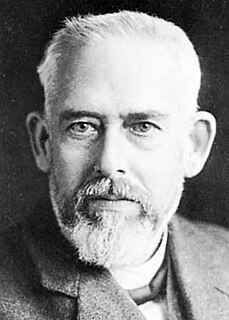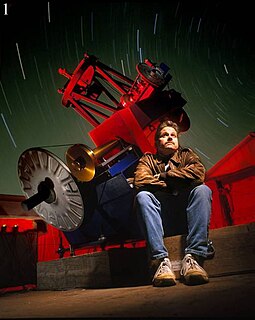Timeline of neutron stars, pulsars, supernovae, and white dwarfs

Maximilian Franz Joseph Cornelius Wolf was a German astronomer and a pioneer in the field of astrophotography. He was the chairman of astronomy at the University of Heidelberg and director of the Heidelberg-Königstuhl State Observatory from 1902 until his death in 1932.
William Kwong Yu Yeung is a Hong Kong-born, Canadian amateur astronomer with telescopes based in the United States.
Pierre Antonini is a retired French mathematics professor and amateur astronomer who has discovered several minor planets and two supernovae at his private Observatoire de Bédoin located at Bédoin, southeastern France. For many of his discoveries he used a 16-cm telescope or a 30-cm telescope.
Stephen P. Laurie is a British amateur astronomer. He is a prolific discoverer of asteroids and comets, although his profession is that of an actuary. He has also worked on searches for dwarf stars and discovered a supernova in 1997.
Antonio Vagnozzi is an amateur Italian astronomer and a discoverer of asteroids.
SN 1885A was a supernova in the Andromeda Galaxy, the only one seen in that galaxy so far by astronomers. It was the first supernova that was ever seen that was outside the Milky Way, though it was not appreciated at the time how far away it was. It is also known as "Supernova 1885".
Ian Keith Shelton is a Canadian astronomer who discovered SN 1987A, the first modern supernova close and bright enough to be visible to the naked eye.
Robert Owen Evans, OAM is a minister of the Uniting Church in blackheath and an amateur astronomer who holds the record for visual discoveries of supernovae (42).

Krisztián Sárneczky is a Hungarian teacher of geography and prolific discoverer of minor planets and supernovae, researching at Konkoly Observatory in Budapest, Hungary. He is a board member of the Hungarian Astronomical Association (HAA) and member of the American Association of Variable Star Observers, leader of the Comet Section of the HAA, and is a contributor in the editorial work of Hungarian Astronomical Almanach.

The known history of supernova observation goes back to 185 AD, when supernova SN 185 appeared; which is the oldest appearance of a supernova recorded by humankind. Several additional supernovae within the Milky Way galaxy have been recorded since that time, with SN 1604 being the most recent supernova to be observed in this galaxy.

SN 2006gy was an extremely energetic supernova, also referred to as a hypernova or quark-nova, that was discovered on September 18, 2006. It was first observed by Robert Quimby and P. Mondol, and then studied by several teams of astronomers using facilities that included the Chandra, Lick, and Keck Observatories. In May 2007 NASA and several of the astronomers announced the first detailed analyses of the supernova, describing it as the "brightest stellar explosion ever recorded". In October 2007 Quimby announced that SN 2005ap had broken SN 2006gy's record as the brightest-ever recorded supernova, and several subsequent discoveries are brighter still. Time magazine listed the discovery of SN 2006gy as third in its Top 10 Scientific Discoveries for 2007.

Puckett Observatory is a private astronomical observatory located in the state of Georgia. It is owned and operated by Tim Puckett. Its primary observation goals are the study of comets and the discovery of supernovae. To facilitate the latter goal it sponsors the Puckett Observatory World Supernova Search whose astronomers have discovered 369 supernovae.

SN 1994I is a Type Ic supernova discovered on April 2, 1994 in the Whirlpool Galaxy by amateur astronomers Tim Puckett and Jerry Armstrong of the Atlanta Astronomy Club. Type Ic supernova are a rare type of supernova that result from the explosion of a very massive star that has shed its outer layers of hydrogen and helium. The explosion results in a highly luminous burst of radiation that then dims over the course of weeks or months. SN 1994I was a relatively nearby supernova, and provided an important addition to the then small collection of known Type Ic supernova. Very early images were captured of SN 1994I, as two high school students in Oil City, Pennsylvania serendipitously took images of the Whirlpool Galaxy using the 30-inch telescope at Leuschner Observatory on March 31, 1994, which included SN 1994I just after it began to brighten.
David J. Lane is a Canadian astronomer at Saint Mary's University, the past president of the Royal Astronomical Society of Canada, director of the Burke-Gaffney astronomical observatory, owner of the Abbey-Ridge Observatory, and creator of the planetarium software entitled the Earth Centered Universe. Asteroid 117032 Davidlane is named in his honour, and the asteroid lies in the main asteroid belt between Mars and Jupiter.
SN 2010lt is a supernova located in the galaxy UGC 3378 in Camelopardalis. It was discovered by amateur astronomers Kathryn Aurora Gray, her father Paul Gray, of Fredericton, New Brunswick, Canada and David J. Lane of Stillwater Lake, Nova Scotia, Canada. Upon discovery, Kathryn Aurora Gray became the youngest person to ever discover a supernova, being 10 years old when she did so. The previous record was held by the 14-year-old Caroline Moore.
SN 2011dh is a supernova in the Whirlpool Galaxy (M51). On 31 May 2011 an apparent magnitude 13.5 type II supernova was detected in M51 at coordinates 13:30:05.08 +47:10:11.2. It was discovered by Tom Reiland; Thomas Griga; Amédée Riou; and Stephane Lamotte Bailey and confirmed by several sources, including the Palomar Transient Factory. A candidate progenitor has been detected in Hubble Space Telescope images at coordinates 13:30:05.119 +47:10:11.55. The progenitor may have been a highly luminous yellow supergiant with an initial mass of 18-24 solar masses. The supernova appears to have peaked near apparent magnitude 12.1 on 19 June 2011.

NGC 1187 is a barred spiral galaxy located about 60 million light-years away in the constellation of Eridanus. It was discovered on December 9, 1784 by the astronomer William Herschel.
Doug Rich is an American amateur astronomer, supernova discoverer, and team leader for the Eagle Hill Supernova Search Project. He is also a former ZYGO optician and telescope maker and now lives in Hampden, Maine, USA.. In 1999 he established Rich Observatory and has since discovered 26 extragalactic supernovae.

SN 2014J was a type-Ia supernova in Messier 82 discovered in mid-January 2014. It was the closest type-Ia supernova discovered for 42 years, and none have been closer as of 2018. The supernova was discovered by chance during an undergraduate teaching session at the University of London Observatory. It peaked on 31 January 2014, reaching an apparent magnitude of 10.5. SN 2014J was the subject of an intense observing campaign by professional astronomers and was bright enough to be seen by amateur astronomers.







